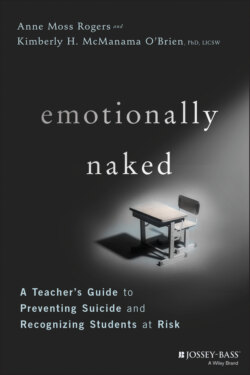Читать книгу Emotionally Naked - Anne Moss Rogers - Страница 20
Barriers to Mental Health Treatment for Teens
ОглавлениеNeither teens nor the adults who are close to them recognize the symptoms of their treatable illness.
Fear of what treatment might involve.
Belief that nothing can help.
They don't see help-seeking as a sign of strength.
They are embarrassed.
Belief that adults won't understand.
Limited access to resources (money, insurance, transportation, healthcare).
Source: From the American Foundation for Suicide Prevention, More Than Sad for Parents.
Standardized testing is a measurement strategy that many school systems use. Wherever you stand on the issue, it siphons considerable instructional time and resources during the school day and the casualties of that effort have been innovation, creativity, practical skills, opportunities to build connection, and social emotional skills. In short, there is not enough time. More trigonometry will not help a student learn how to cope with the loss of a sibling. Integrating skills to help students learn and manage life goes a long way in minimizing substance misuse, self-harm, eating disorders, promiscuity, and other unhealthy coping strategies, as well as preventing suicide during the school years and throughout a student's lifespan. What we do know is that several studies have shown that suicide rates increase during the school year and drop off during the summer when most students are out of school and during academic breaks, suggesting that social and academic pressure may play a role in student suicidal behavior.
In a 2018 study, Gregory Plemmons and his colleagues found that the rate of hospitalization of school-aged children for suicidal ideation and attempts increased by almost 300% from 2008 to 2015.3 Each year the rate of psychiatric hospitalizations is significantly higher in the school months than in the summer. A decrease occurred not just during summer vacation, but also during school vacation weeks, too. So in schools where parents are more involved and academic success and college prep are paramount, for example, the pressure of grades and college acceptance can be a contributor to student suicide risk and attempts.
Social media is another factor that can either boost student well-being or crush it. It's the lollipop land of shiny faces and perfect families, and in our accomplishment-obsessed culture, this highlight reel of influencers, likes, and comments can alter a student's feelings of self-worth. Positive interactions, social support, and connectedness on social networking sites are consistently related to lower levels of depression and anxiety. Conversely, negative interaction and social comparisons on social networking sites are related to higher levels.4 Extended time spent on these sites results in negative mental health outcomes.5 With an adolescent population, feelings of inclusion can shift fast, triggering impulsive thoughts and actions. For example, a student who is experiencing a great day can see a status update by another student that includes pictures to a party she wasn't invited to and her mood can transform from happiness to despair in seconds. Teens are more susceptible to social influence, the need for peer approval, and the conformity effect, which drives some adolescents to agree with or engage with what their friends have already commented on or liked.
